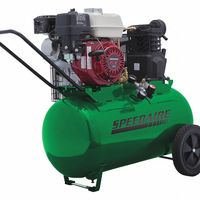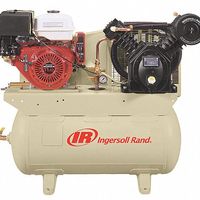Call +(254) 703 030 000 / 751 483 999 / 721 704 777
- Home
- Pneumatics
- Air Compressors Vacuum Pumps Blowers
- Air Compressors
- Engine Driven Air Compressors
.....Read More
Frequently Asked Questions
What are the benefits of using an engine-driven air compressor?
1. **Portability**: Engine-driven air compressors are not reliant on electrical power sources, making them highly portable and ideal for remote locations or job sites without electricity.
2. **Versatility**: They can power a wide range of pneumatic tools and equipment, making them suitable for various applications in construction, automotive, and industrial sectors.
3. **Independence from Electrical Grid**: These compressors are perfect for outdoor or rural areas where access to electricity is limited or unavailable.
4. **High Power Output**: Engine-driven compressors often provide higher power output compared to electric models, enabling them to handle more demanding tasks and operate larger tools.
5. **Continuous Operation**: They can run continuously for extended periods, which is beneficial for tasks requiring sustained air pressure without the risk of overheating associated with electric models.
6. **Durability**: Built to withstand harsh environments, these compressors are typically more robust and durable, ensuring longevity and reliability in tough working conditions.
7. **Flexibility in Fuel Options**: Many models can run on various fuels such as gasoline, diesel, or propane, offering flexibility depending on fuel availability and cost.
8. **Reduced Downtime**: With no dependency on electrical power, there is less risk of downtime due to power outages, ensuring consistent productivity.
9. **Cost-Effective for Large-Scale Operations**: For large-scale operations, the initial investment in an engine-driven compressor can be offset by the savings in operational efficiency and reduced need for electrical infrastructure.
10. **Ease of Maintenance**: These compressors are generally easier to maintain in the field, with straightforward access to engine components for repairs and servicing.
How do I maintain an engine-driven air compressor?
1. **Regular Inspection**: Check for leaks, unusual noises, and vibrations. Inspect hoses, belts, and connections for wear and tear.
2. **Oil Maintenance**: Regularly check and change the compressor oil. Use the manufacturer-recommended oil type and maintain the correct oil level.
3. **Air Filter Cleaning/Replacement**: Clean or replace the air filter regularly to ensure efficient airflow and prevent contaminants from entering the system.
4. **Fuel System Check**: Inspect the fuel lines, filter, and tank for leaks or blockages. Ensure the fuel is clean and fresh.
5. **Cooling System Maintenance**: Ensure the cooling fins and fan are clean and unobstructed. Check coolant levels if applicable.
6. **Belt and Pulley Inspection**: Check for proper tension and alignment. Replace worn or damaged belts.
7. **Drain Moisture**: Regularly drain moisture from the air receiver tank to prevent rust and corrosion.
8. **Safety Valve Testing**: Test the safety valve periodically to ensure it operates correctly and releases pressure at the designated level.
9. **Battery Maintenance**: If applicable, check the battery for charge and clean terminals to ensure proper electrical connections.
10. **Spark Plug Check**: Inspect and clean or replace spark plugs as needed for efficient engine performance.
11. **Exhaust System Inspection**: Check for blockages or damage to ensure proper exhaust flow and reduce emissions.
12. **Lubrication**: Lubricate moving parts as per the manufacturer's guidelines to reduce friction and wear.
13. **Record Keeping**: Maintain a log of maintenance activities, including dates and actions taken, to track performance and anticipate future needs.
14. **Follow Manufacturer Guidelines**: Adhere to the specific maintenance schedule and procedures outlined in the user manual for optimal performance and longevity.
What fuel types are compatible with engine-driven air compressors?
Engine-driven air compressors are compatible with several fuel types, each offering distinct advantages and considerations:
1. **Gasoline**: Widely used due to its availability and ease of use. Gasoline-powered compressors are portable and suitable for various outdoor applications. They are ideal for small to medium-sized tasks but may require more maintenance due to carbon buildup and shorter engine life compared to diesel.
2. **Diesel**: Known for durability and fuel efficiency, diesel engines are preferred for heavy-duty applications and continuous use. They offer more torque and are more fuel-efficient than gasoline engines. Diesel compressors are often used in construction and industrial settings but are heavier and more expensive.
3. **Propane**: Offers a cleaner-burning alternative with fewer emissions compared to gasoline and diesel. Propane-powered compressors are suitable for environments where emissions are a concern. They provide good portability and are often used in remote locations, but require access to propane refueling infrastructure.
4. **Natural Gas**: Used primarily in stationary compressors, natural gas is cost-effective and environmentally friendly. It is suitable for industrial applications where a constant fuel supply is available. However, it lacks portability and is not ideal for remote or mobile operations.
5. **Dual-Fuel**: Some compressors are designed to operate on more than one type of fuel, such as gasoline and propane. This flexibility allows users to switch fuels based on availability and cost, providing versatility in various working conditions.
Each fuel type has its own set of benefits and limitations, and the choice depends on factors like application, location, cost, and environmental considerations.
How do I choose the right size engine-driven air compressor for my needs?
1. **Determine Air Requirements**: Calculate the total air consumption of all tools and equipment that will be used simultaneously. Check the CFM (cubic feet per minute) requirements for each tool.
2. **Consider Duty Cycle**: Assess how often the compressor will be used. For continuous use, choose a compressor with a higher duty cycle.
3. **Evaluate Pressure Needs**: Identify the PSI (pounds per square inch) requirements of your tools. Ensure the compressor can deliver the necessary pressure.
4. **Portability and Space**: Decide if you need a portable compressor or a stationary one. Consider the available space for installation.
5. **Power Source**: Ensure the engine type (gasoline or diesel) is suitable for your location and usage conditions.
6. **Tank Size**: Larger tanks are better for prolonged use, while smaller tanks are suitable for intermittent use.
7. **Environment**: Consider the working environment. For outdoor or remote locations, ensure the compressor is rugged and weather-resistant.
8. **Budget**: Balance your needs with your budget. Higher capacity and quality often come at a higher cost.
9. **Brand and Warranty**: Choose reputable brands with good customer support and warranty options.
10. **Future Expansion**: Consider potential future needs to avoid outgrowing the compressor too quickly.
11. **Noise Levels**: If noise is a concern, look for compressors with lower decibel ratings.
12. **Maintenance and Service**: Check the ease of maintenance and availability of service centers.
13. **Safety Features**: Ensure the compressor has necessary safety features like pressure relief valves and thermal protection.
By considering these factors, you can select an engine-driven air compressor that meets your specific requirements efficiently.
What safety precautions should I take when using an engine-driven air compressor?
1. **Read the Manual**: Familiarize yourself with the manufacturer's instructions and safety guidelines.
2. **Personal Protective Equipment (PPE)**: Wear safety goggles, gloves, and hearing protection to guard against debris, noise, and accidental contact with hot or moving parts.
3. **Proper Ventilation**: Operate the compressor in a well-ventilated area to prevent the buildup of exhaust fumes, which can be toxic.
4. **Stable Surface**: Place the compressor on a flat, stable surface to prevent tipping or movement during operation.
5. **Inspect Before Use**: Check for any damage, leaks, or loose connections in hoses and fittings. Ensure all safety guards are in place.
6. **Fuel Safety**: Refuel the engine only when it is off and cool to prevent fire hazards. Use the correct type of fuel as specified by the manufacturer.
7. **Avoid Overloading**: Do not exceed the compressor's rated capacity. Overloading can cause overheating and mechanical failure.
8. **Secure Connections**: Ensure all hoses and tools are securely connected to prevent accidental disconnection and potential injury.
9. **Pressure Relief Valve**: Regularly test the pressure relief valve to ensure it is functioning properly to prevent over-pressurization.
10. **Emergency Shutoff**: Know the location and operation of the emergency shutoff switch for quick access in case of malfunction.
11. **Avoid Flammable Materials**: Keep the compressor away from flammable materials and sources of ignition.
12. **Regular Maintenance**: Perform routine maintenance as recommended by the manufacturer, including oil changes and filter replacements.
13. **Training**: Ensure all operators are properly trained in the use and safety procedures of the compressor.
14. **Monitor Operation**: Continuously monitor the compressor during use for any unusual noises or vibrations, and shut it down immediately if any are detected.
How do I troubleshoot common issues with engine-driven air compressors?
1. **Check Fuel Supply**: Ensure the fuel tank is filled and the fuel is fresh. Inspect fuel lines for leaks or blockages.
2. **Inspect Air Filter**: Remove and clean or replace the air filter if it’s dirty or clogged, as this can restrict airflow and reduce performance.
3. **Examine Oil Levels**: Check the oil level and quality. Refill or change the oil if it’s low or dirty to prevent engine damage.
4. **Spark Plug Inspection**: Remove the spark plug and check for wear or carbon buildup. Clean or replace it if necessary to ensure proper ignition.
5. **Battery and Electrical Connections**: Ensure the battery is charged and terminals are clean and tight. Check all electrical connections for corrosion or looseness.
6. **Check Belts and Pulleys**: Inspect belts for wear or damage and ensure they are properly tensioned. Check pulleys for alignment and secure attachment.
7. **Inspect Hoses and Fittings**: Look for leaks, cracks, or damage in hoses and fittings. Tighten or replace as needed to maintain proper air pressure.
8. **Pressure Switch and Regulator**: Ensure the pressure switch is functioning correctly and the regulator is set to the desired pressure. Adjust or replace if malfunctioning.
9. **Safety Valve**: Test the safety valve to ensure it releases pressure at the correct setting. Replace if it fails to operate properly.
10. **Cooling System**: Check the cooling system for blockages or leaks. Ensure the cooling fan is operational to prevent overheating.
11. **Listen for Unusual Noises**: Unusual noises can indicate mechanical issues. Investigate and address any abnormal sounds promptly.
12. **Consult Manual**: Refer to the manufacturer’s manual for specific troubleshooting steps and maintenance schedules.
13. **Professional Service**: If issues persist, consult a professional technician for a thorough inspection and repair.
Can engine-driven air compressors be used in all weather conditions?
Engine-driven air compressors can generally be used in a variety of weather conditions, but there are important considerations and limitations to keep in mind:
1. **Temperature Extremes**: In cold weather, engine-driven compressors may face starting difficulties due to thickened oil and battery issues. Pre-heaters or synthetic oils can mitigate these problems. In hot weather, overheating can be a concern, so adequate ventilation and cooling systems are necessary.
2. **Humidity and Moisture**: High humidity can lead to moisture accumulation in the compressor, which can cause rust and damage. Using moisture separators and regular maintenance can help manage this issue.
3. **Rain and Wet Conditions**: While many compressors are designed to withstand some exposure to rain, prolonged exposure can lead to electrical issues and corrosion. Protective covers or enclosures are recommended to shield the equipment.
4. **Dust and Debris**: In dusty environments, air filters can become clogged, reducing efficiency and potentially damaging the engine. Regular cleaning and maintenance of filters are essential.
5. **Altitude**: At high altitudes, the engine may experience reduced performance due to lower oxygen levels. Adjustments to the fuel mixture or using a turbocharged engine can help maintain efficiency.
6. **Wind**: Strong winds can affect the stability of the compressor and may require additional anchoring or protection.
In summary, while engine-driven air compressors are versatile and can operate in various weather conditions, they require specific precautions and maintenance to ensure optimal performance and longevity.

